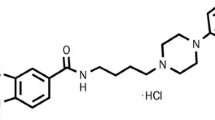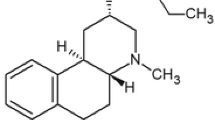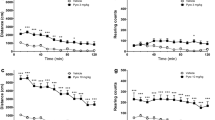Abstract
Rationale
2-[4-(4-Chlorophenyl)piperazin-1-ylmethyl]pyrazolo[1,5-a]pyridine (FAUC 213) is a highly selective antagonist at the dopamine D4 receptor subtype. It was designed as a derivative of two partial antagonists and has been proven to be a complete antagonist in mitogenesis assay.
Objectives
In the present study, FAUC 213 was examined for antipsychotic properties in animal models of behavioural neurobiology and neurochemistry.
Methods
Different concentrations of FAUC 213 were screened for effects on spontaneous, as well as amphetamine-induced, locomotor activity and apomorphine-induced prepulse disruption. The liability of causing extrapyramidal side effects was investigated in models of catalepsy and by high-performance liquid chromatography (HPLC) detection of dopamine turnover in several brain regions. The application schedule was validated, and the bioavailability of the compound determined, by means of a HPLC-pharmacokinetic study.
Results
A significant effect in both the reduction of amphetamine-induced locomotor hyperactivity and the restoration of apomorphine-disrupted prepulse inhibition was found at 30 mg/kg. This dose proved not to be high enough to induce catalepsy or to increase dopamine turnover in the dorsal striatum, nucleus accumbens and medial prefrontal cortex. The selective D4 antagonist FAUC 213, therefore, is not believed to mediate the above-mentioned effects via D2 receptor antagonism, but a partial involvement of 5-HT2- and α1-receptors cannot be ruled out at present.
Conclusions
We have gathered evidence that FAUC 213 exhibits atypical antipsychotic characteristics.








Similar content being viewed by others
References
Ariano MA, Wang J, Noblett KL, Larson ER, Sibley DR (1997) Cellular distribution of the rat D4 dopamine receptor protein in the CNS using anti-receptor antisera. Brain Res 752:26–34
Arnt J, Skarsfeldt T (1998) Do novel antipsychotics have similar pharmacological characteristics? A review of the evidence. Neuropsychopharmacology 18:63–101
Bakshi VP, Geyer MA (1997) Phencyclidine-induced deficits in prepulse inhibition of startle are blocked by prazosin, an alpha-1 noradrenergic antagonist. J Pharmacol Exp Ther 283:666–674
Braff DL, Geyer MA, Swerdlow NR (2001) Human studies of prepulse inhibition of startle: normal subjects, patient groups, and pharmacological studies. Psychopharmacology 156:234–258
Bristow LJ, Collinson N, Cook GP, Curtis N, Freedman SB, Kulagowski JJ, Leeson PD, Patel S, Ragan CI, Ridgill M, Saywell KL, Tricklebank MD (1997) L-745,870, a subtype selective dopamine D4 receptor antagonist, does not exhibit a neuroleptic-like profile in rodent behavioral tests. J Pharmacol Exp Ther 283:1256–1263
Chabert C, Cavegn C, Bernard A, Mills A (1994) Characterisation of the functional activity of dopamine ligands at human recombinant dopamine D4 receptors. J Neurochem 63:62–65
Defagot MC, Malchiodi EL, Villar MJ, Antonelli MC (1997) Distribution of D4 dopamine receptor in rat brain with sequence specific antibodies. Mol Brain Res 45:1–12
De La Garza R II, Madras BK (2000) [(3)H]PNU-101958, a D(4) dopamine receptor probe, accumulates in prefrontal cortex and hippocampus of non-human primate brain. Synapse 37:232–244
Dulawa SC, Gross C, Stark KL, Hen R, Geyer MA (2000) Knockout mice reveal opposite roles for serotonin 1A and 1B receptors in prepulse inhibition. Neuropsychopharmacology 22:650–659
Ellenbroek BA, Peeters BW, Honig WM, Cools AR (1987) The paw test: a behavioural paradigm for differentiating between classical and atypical neuroleptic drugs. Psychopharmacology 93:343–348
Gazi L, Bobirnac I, Danzeisen M, Schupbach E, Bruinvels AT, Geisse S, Sommer B, Hoyer D, Tricklebank M, Schoeffter P (1998) The agonist activities of the putative antipsychotic agents, L-745,870 and U-101958 in HEK293 cells expressing the human dopamine D4.4 receptor. Br J Pharmacol 124:889–896
Gazi L, Bobirnac I, Danzeisen M, Schüpbach E, Langenegger D, Sommer B, Hoyer D, Tricklebank M, Schoeffter P (1999) Receptor density as a factor governing the efficacy of the dopamine D4 receptor ligands, L-745,870 and U-101958 at human recombinant D4.4 receptors expressed in CHO cells. Br J Pharmacol 128:613–620
Geyer MA, Swerdlow NR, Mansbach RS, Braff DL (1990) Startle response models of sensorimotor gating and habituation deficits in schizophrenia. Brain Res Bull 25:485–498
Geyer MA, Krebs-Thomson K, Varty GB (1999) The effects of M100907 in pharmacological and developmental animal models of prepulse inhibition deficits in schizophrenia. Neuropsychopharmacology 21:S134–S142
Geyer MA, Krebs-Thomson K, Braff DL, Swerdlow NR (2001) Pharmacological studies of prepulse inhibition models of sensorimotor gating deficits in schizophrenia: a decade in review. Psychopharmacology 156:117–154
Hübner H, Kraxner J, Gmeiner P (2000) Cyanoindole derivatives as highly selective dopamine D4 receptor partial agonists: solid-phase synthesis, binding assays, and functional experiments. J Med Chem 43:4563–4569
Karoum F, Egan MF (1992) Dopamine release and metabolism in the rat frontal cortex, nucleus accumbens, and striatum: a comparison of acute clozapine and haloperidol. Br J Pharmacol 105:703–707
Koch M (1999) The neurobiology of startle. Prog Neurobiol 59:107–128
Kuschinsky K, Hornykiewicz O (1972) Morphine catalepsy in the rat: relation to striatal dopamine metabolism. Eur J Pharmacol 19:119–122
Lahti RA, Roberts RC, Cochrane EV, Primus RJ, Gallagher DW, Conley RR, Tamminaga CA (1998) Direct determination of dopamine D4 receptors in normal and schizophrenic brain tissue: a [3H]NGD 94-1 study. Mol Psychiatry 3:528–533
Löber S, Hübner H, Utz W, Gmeiner P (2001) Rationally based efficacy tuning of selective dopamine D4 receptor ligands leading to the complete antagonist 2-[4-(4-chlorophenyl)piperazin-1-ylmethyl]pyrazolo[1,5-a]pyridine (FAUC 213). J Med Chem 44:2691–2694
Mansbach RS, Brooks EW, Sanner MA, Zorn SH (1998) Selective dopamine D4 receptor antagonists reverse apomorphine-induced blockade of prepulse inhibition. Psychopharmacology 135:194–200
Matsumoto M, Hidaka K, Tada S, Tasaki Y, Yamaguchi T (1995) Full-length cDNA cloning and distribution of human dopamine D4 receptor. Mol Brain Res 29:157–162
Matsumoto M, Hidaka K, Tada S, Tasaki Y, Yamaguchi T (1996) Low levels of mRNA for dopamine D4 receptor in human cerebral cortex and striatum. J Neurochem 66:915–919
Mrzljak L, Bergson C, Pappy M, Huff R, Levenson R, Goldmanrakic PS (1996) Localization of dopamine D4 receptors in GABAergic neurons of the primate brain. Nature 381:245–248
Mulcrone J, Kerwin RW (1997) The regional pattern of D4 gene expression in human brain. Neurosci Lett 234:147–150
Newman-Tancredi A, Audinot V, Chaput V, Verrièle L, Millan MJ (1997) [35S]-Guanosine-5’-O-(3-thio)triphosphate binding as a measure of efficacy at human recombinant dopamine D4.4 receptors: actions of antiparkinsonian and antipsychotic agents. J Pharmacol Exp Ther 282:181–191
Patel S, Freedman S, Chapman KL, Emms F, Fletcher AE, Knowles M, Marwood R, McAllister G, Patel S, Curtis N, Kulagowski JJ, Leeson PD, Ridgill M, Graham M, Matheson S, Rathbone D, Watt AP, Bristow LJ, Rupniak NMJ, Baskin E, Lynch JJ, Ragan CI (1997) Biological profile of L-745,870, a selective antagonist with high affinity for the dopamine D4 receptor. J Pharmacol Exp Ther 283:636–647
Paxinos G, Watson C (1986) The rat brain in stereotaxic coordinates, 2nd edn. Academic Press, New York
Primus RJ, Thurkauf A, Xu J, Yevich E, McInerney S, Shaw K, Tallman JF, Gallager DW (1997) II. Localisation and characterisation of dopamine D4 binding sites in rat and human brain by use of the novel D4 receptor selective ligand [3H]NGD 94-1. J Pharmacol Exp Ther 282:1020–1027
Remington G, Kapur S (2000) Atypical antipsychotics: are some more atypical than others? Psychopharmacology 148:3–15
Reynolds GP, Mason SL (1995) Absence of detectable striatal dopamine D4 receptors in drug-treated schizophrenia. Eur J Pharmacol 281:R5–R6
Roth BL, Tandra S, Burgess LH, Sibley DR, Meltzer HY (1995) D4 dopamine receptor binding affinity does not distinguish between typical and atypical antipsychotic drugs. Psychopharmacology 120:365–368
Rowley M, Bristow LJ, Hutson PH (2001) Current and novel approaches to the drug treatment of schizophrenia. J Med Chem 44:477–501
Seeman P (1995) Therapeutic receptor-blocking concentrations of neuroleptics. Int Clin Psychopharmacol 10:5–13
Seeman P, Van Tol HHM (1995) Deriving the therapeutic concentrations for clozapine and haloperidol: the apparent dissociation constant of a neuroleptic at the dopamine D2 or D4 receptor varies with the affinity of the competing radioligand. Eur J Pharmacol 291:59–66
Seeman P, Guan HC, Van Tol HHM (1993) Dopamine D4 receptors elevated in schizophrenia. Nature 365:441–445
Seeman P, Guan H-C, Van Tol HHM (1995) Schizophrenia: elevation of dopamine D4-like sites, using [3H]nemonapride and [125I]epidepride. Eur J Pharamcol 286:R3–R5
Seeman P, Corbett R, Van Tol HHM (1997) Atypical neuroleptics have low affinity for dopamine D2 receptors or are selective for D4 receptors. Neuropsychopharmacology 16:93–110
Snyder SH (1996) Drugs and the brain. Scientific American Library, New York
Van Tol HHM, Bunzow JR, Guan H-C, Sunahara RK, Seeman P, Niznik HB, Civelli O (1991) Cloning of the gene for a human dopamine D4 receptor with high affinity for the antipsychotic clozapine. Nature 350:610–614
Westerink BHC (1985) Sequence and significance of dopamine metabolism in the rat brain. Neurochem Int 7:221–227
Acknowledgements
This work was supported by grants from the ETH Zürich, Switzerland and the Friedrich-Alexander University of Erlangen, Germany. We thank Mr. A.N.A. Ipekian for linguistic revision of the manuscript.
Author information
Authors and Affiliations
Corresponding author
Rights and permissions
About this article
Cite this article
Boeckler, F., Russig, H., Zhang, W. et al. FAUC 213, a highly selective dopamine D4 receptor full antagonist, exhibits atypical antipsychotic properties in behavioural and neurochemical models of schizophrenia. Psychopharmacology 175, 7–17 (2004). https://doi.org/10.1007/s00213-004-1782-1
Received:
Accepted:
Published:
Issue Date:
DOI: https://doi.org/10.1007/s00213-004-1782-1




